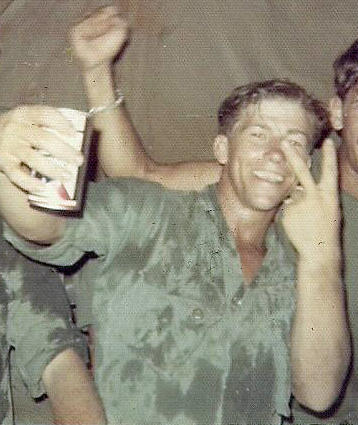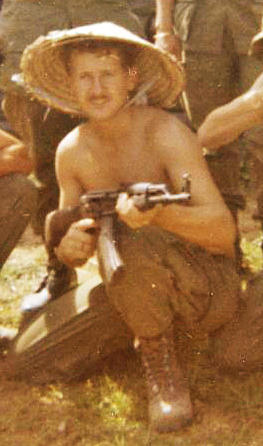![]() 1st Battalion 22nd Infantry
1st Battalion 22nd Infantry ![]()
The Vietnamese rat
by Michael Belis
The Vietnamese rat was a mighty
creature. It lived everywhere the US infantryman went in Vietnam.
Firebases, base camps,
mountains or coastal plains, no place was safe from its
onslaught. It was ugly, big, fearless and hungry. An Eleven-Bravo
(infantryman) in Vietnam either killed rats or learned to live
with them. Their presence was a fact of life.
Sergeant Huey Livingston was
Squad Leader for 1st Squad, 3rd Platoon of Charlie Company, 1/22
Infantry, 4th Infantry Division
in the fall of 1970. He had guts and experience, two qualities
that were very important for a Squad Leader in the jungle. He
came
from the Deep South, a hard drinking dusty-haired good old boy in
every sense of the word and he was an excellent man
to follow up and down those triple-canopied jungle covered
mountains of Binh Dinh Province.
Livingston appeared to be afraid
of nothing, most certainly neither man nor beast, with one
exception. He really didn’t like rats.
The presence of one of the hairy animals could move him into
furious spasms of action. His initial reaction was always the
same.
A slow and orderly withdrawal was unthinkable. His plan of action
called for immediate removal of himself from the area, bulldozing
anyone or anything in his way. Upon reaching safety he would then
counterattack with ferocity unmatched in human history.
The rat that surprised Livingston sealed its own fate and found
itself with only minutes, even seconds left to live.

Huey Livingston at the
Base Camp at An Khe with his ever present can of
Pabst Blue Ribbon beer August 1970
Photo by Randy Cox
Sometime in October 1970 our
Platoon was rotated to a firebase to get a breather from humping
the jungle. The firebase
was small. It was on a hilltop that jutted out into a valley
surrounded by three higher hilltops. There were two M102 105mm
howitzers
there, I don’t remember for sure but they were probably from
4/42 Artillery. There was also a ground surveillance radar unit.
As I recall
that unit was some kind of people detecting wizardry and at one
time one of our guys came back from visiting the radar and its
operators,
impressed that the radar had spotted several enemy soldiers
walking in the jungle passing by us carrying what might have been
B-40 rockets.
Our Weapons Platoon had been
reassembled from the various Rifle Platoons its personnel had
been assigned to and had their
81mm mortars set up at the firebase. We had moved deep into the
mountains beyond the range of any artillery on any existing
firebase.
Engineers had been flown out and together with Weapons Platoon
they built this firebase so a couple of artillery pieces could
cover
our movements. The hilltop this firebase had been built on was
selected because it was devoid of trees, being covered instead
with
razor grass which grew about four feet tall and was so named
because the minutely serrated edges of each blade of grass could
scratch and cut exposed skin when rubbed against it.
I remember the firebase being
called LZ Regular but Gary Rabideau from Weapons Platoon, who was
one of the guys who actually
built the firebase remembers it being called LZ Popeye, so Popeye
most likely was its official designation. Popeye was the nickname
of Weapons Platoon for our Company. Weapons Platoon guarded one
half of the firebase and our Rifle Platoon
(nicknamed Sidewinder) guarded the other half.
Our outer perimeter consisted of
sandbag-ringed foxholes with no overhead cover. The inner
perimeter was made of covered bunkers
used as sleeping quarters. Gary and the guys from Weapons Platoon
had large 4 foot wide semi-circle culvert sections on their side
of the firebase covered with sandbags as sleeping quarters. On
our Rifle platoon side we had a square bunker used as sleeping
quarters
for the position I was assigned to. This bunker was dug into the
ground and had thick timbers for the roof which had been air
lifted
out to the firebase by large Chinook helicopters. The timbers
were covered by sheet plastic with a layer or two of sandbags on
top
of that. The bunker had a single entrance and inside there was
room for either 3 or 4 men to sleep side by side on their air
mattresses.
The bunker was deep enough so
you could sit upright in it or crawl on your hands and knees but
not deep enough to stand up in.
The dirt just below the roof had been scraped out, making a
recessed shelf that ran all the way around the inside. The shelf
was
perfect for small items including a jungle candle (made from the
wax and paper insulation wrappings of mortar shells) or the more
customary,
a c-ration candle, made of a tin of peanut butter to which we
would add liquid insect repellent. The oil from the peanut butter
mixed with the
chemicals in the insect repellent burned like lamp oil in the
small short tin the peanut butter came in and gave off light like
a small hurricane lamp.
The rats of course got in our
bunker as well and you could count on seeing one of them in the
bunker just about every day.
An entrenching tool or a well-placed foot would usually dispatch
them quickly enough. One day I went into our un-occupied bunker
to get something and was carrying my loaded rifle. As I came
through the entrance, thanks to the light from a burning candle
inside
the bunker I saw a rat on the shelf opposite me. I flipped off
the safety on my rifle and blasted the rat.
Blast is the right word. In the
confined and enclosed space of the bunker the single shot of the
high velocity M16 rifle erupted
like an atom bomb. Since there were no windows or slits in the
bunker and my body was blocking the only opening, the sound and
concussion had nowhere to go but right in my face. The sound was
deafening and the pain from the sudden and violent displacement
of air molecules against my head, nose and ears was intense. I
felt as if two giant hands had clapped together hard, with my
head
in between them. I never again made that foolish mistake of
firing a weapon inside an enclosed bunker.
Livingston had decided he
wasn’t going to sleep inside the bunker with the rats
anymore. He placed his air mattress on the
sandbagged roof of the bunker. One evening as three of us stood
next to the bunker having a conversation Livingston settled
onto his mattress and lay on his back in the dimming light of
dusk. Very soon after he fell asleep a rat appeared out of
nowhere
and sat next to his feet. We watched with amusement as the rat
climbed onto Livingston’s boot and slowly made its way up
his body.
It would move a few inches, stop and rub its nose or wiggle its
whiskers or just sit there looking so comical that we all started
to
snicker and laugh. It would move a little farther and stop again
and look at us and then look at Livingston before continuing its
trek
up his leg, over his knee, up his thigh, carrying on its journey
across Livingston’s body.
By the time it got to his waist
we were doubled over with laughter, holding our hands over our
mouths to stifle our sounds.
The rat continued and then stopped on his chest and at that
moment Livingston awoke and found himself eyeball to eyeball
with the rat. We exploded with shrieks of laughter so deep it
brought tears to our eyes. Shillings was laughing so hard
he was rolling on the ground.
Livingston jumped up and flew
off that bunker ending up several yards down the hill. We all
scrambled for cover
as he found his rifle and assaulted the rat. The rat however, had
already sought refuge and was nowhere to be found.
Livingston’s curses could probably be heard throughout the
whole valley. We enjoyed telling that story for weeks,
each time ending it with Livingston’s declaration
“god-damn rats!”

Henry Shillings – a
seasoned veteran who teased me unmercifully about being a new guy
(FNG) when I was first assigned
to 1/22 Infantry. He and other experienced soldiers like Huey
Livingston, Ron Sorrento and David Hester taught me a lot about
how to survive in the jungle. I took this photo at the Base Camp
at Camp Radcliff, An Khe in late 1970 as we were posing for
photos
with captured enemy weapons.
Photo by Michael Belis
Home | Photos | Battles & History | Current |
Rosters & Reports | Medal of Honor | Killed
in Action |
Personnel Locator | Commanders | Station
List | Campaigns |
Honors | Insignia & Memorabilia | 4-42
Artillery | Taps |
What's New | Editorial | Links |